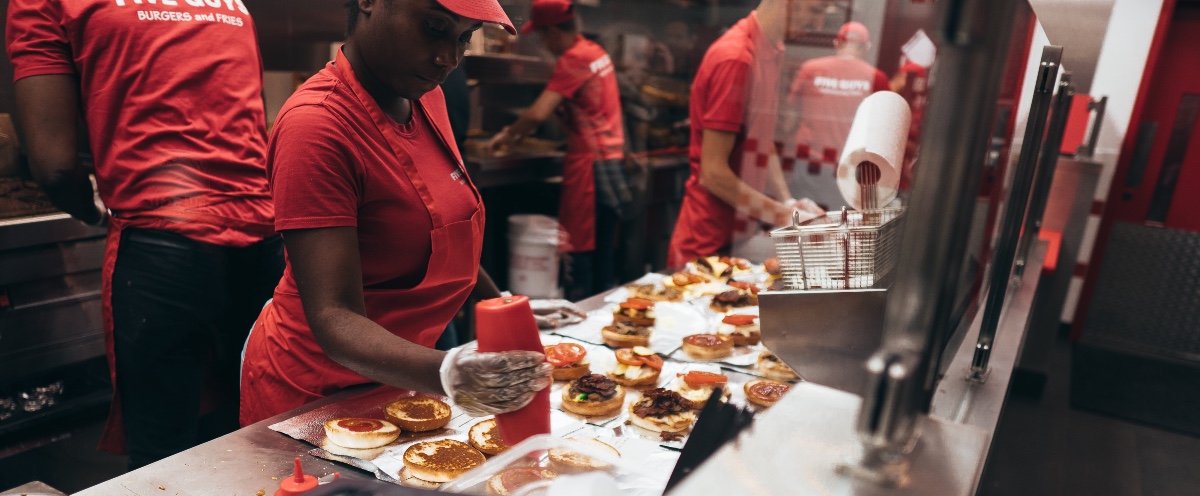MRM EXCLUSIVE: Fast Food Has Become a Hi-Tech Job
4 Min Read By Derek Stangle
Consumers visit a fast food or quick serve restaurant (QSR) with a goal in mind: secure a tasty meal incredibly quickly. Who makes the magic happen? Cashiers, cooks, and other QSR crew members.
Once upon a time, a frontline employee at a fast food restaurant did not necessarily need technological skills to apply for the job. Taking orders at the counter and preparing quick meals were not necessarily perceived as stepping stones to better-paid careers with expanded responsibilities. Fast forward to 2022. Technology has permeated the quick serve restaurant industry and job functions – from point of sale (POS) to complying with food safety standards. QSR workers, like everyone else, are expected to use technology on the job. And many have risen to the occasion.
Wireless networks, wearable computers and the internet of things (IoT) have transformed QSRs into hi-tech hotspots and the employees who staff them into a skilled workforce. In fact, the hi-tech workplace is no longer the domain of office workers glued to computer screens. The hi-tech workforce has expanded into factories, warehouses, ecommerce delivery fleets, and this article’s focus: quick serve restaurants.
The pace of restaurant technology adoption has accelerated in response to the COVID-19 pandemic. Restaurant and retail employees were hard to come by while the number of channels for interacting with customers multiplied. To stay competitive, the majority of restaurants and retailers moved beyond in-store transactions to adopt more technological methods such as online ordering, curbside and in-store pickup as well as delivery services. Additionally, food safety became increasingly more important to consumers and business alike, across all of these channels.
The Technologies Behind Modern Restaurant Work
QSR workers are learning to use new technologies at a faster pace than ever before. From digital checklists to wireless food temperature monitoring and robotics – let’s dive into some of the key technologies driving change among the QSR workforce.
Portable Computing – Tablets, cell phones and wearable computers make it possible for staff to access software applications as they move about the store. Checklists that were once manual and paper-based are now automated and digital. The front of the house features POS tablets as well as tablets loaded with digital checklists that chronicle everything from opening and closing tasks to basic store hygiene functions. Digitized food safety checklists provide a real-time view into compliance across the store for both store operators as well as corporate headquarters. Digitizing task checklists has enabled restaurant employees to spend less time on manual, “pen-and-paper” task-tracking, and more time focusing on customers.
Digital Food Temperature Monitoring– The Internet of Things has enabled restaurants to connect various objects, such as heat sensors or cameras, with data processing capabilities and software over a wireless network. One of the biggest advances has been the ability to effortlessly monitor food temperatures and achieve new levels of food safety. Remote Temperature Monitoring systems that leverage advanced LoRaWAN technology can even read individual food temperatures through the walls of freezers or refrigerators. The result is effortless compliance. Temperature logs are automatically captured and sent to management dashboard reports for 24/7 monitoring. Real-time alerts warn staff if a temperature-sensitive location falls out of acceptable range. Restaurant managers can now detect and avoid equipment failures before they happen.
Shift Management Software – Store operators have full visibility into staff performance via digital checklists tracking everything from pre-shift activities (cleaning tables, stocking freezers) to shift notes (e.g. “running low on bread”) and even COVID-19 safety checks. Customers notice the difference between a spotless QSR with a clean dining area and fully-stocked inventory, and these details may move the needle to encourage a first-time customer to become a repeat customer. While employees on the ground enjoy the benefits of digital checklists, managers can now experience “real-time” management through online performance dashboards, mobile apps, real-time alerts, and daily emails. Formerly time-intensive tasks for managers, such as filling a shift for an employee who has called in sick, can be resolved quickly with a text to notify everyone of the shift opening. The same is true for weather emergencies, such as a delayed store opening due to a snow storm.
Robotics – A recent BostInno article included this video of Alfred the Robot making salads at BONAPITA, a fast-casual Mediterranean restaurant in West Roxbury, MA. Meanwhile, at San Francisco’s Creator Restaurant, a robot completes every aspect of creating a burger – from toasting the bun to applying the ketchup! The robots are most likely slower than a food prep chef or a line cook, but they are reliable and cost-effective at a time when employees can be expensive and hard to find. Filling certain food prep roles with robots also allows human QSR employees to spend less time on labor-intensive, time consuming tasks, and instead focus on customers – creating a more valuable customer experience.
The Restaurant Job of the Future: Tech-Savvy and Customer-Centric
Today’s restaurant workers need to be familiar with tablets and the applications running on them. They may be expected to download staffing apps onto their personal cell phones for communication purposes or smartwatches so cooks and other staff can respond to applications on a wearable device in order to keep their hands free for work.
There’s also a growing role for skilled technicians to train, manage and repair this pervasive restaurant technology. Managers also have more insight into what their staff is doing and more data to assist them in managing and helping employees grow in their roles.
Technology is making front and back of house operations more thorough and dependable. It’s helping employees track orders, serve quality food, and prioritize customer service. . Like any other employees, people working in restaurants are embracing technology to work smarter and faster, with an end goal of delighting customers.


